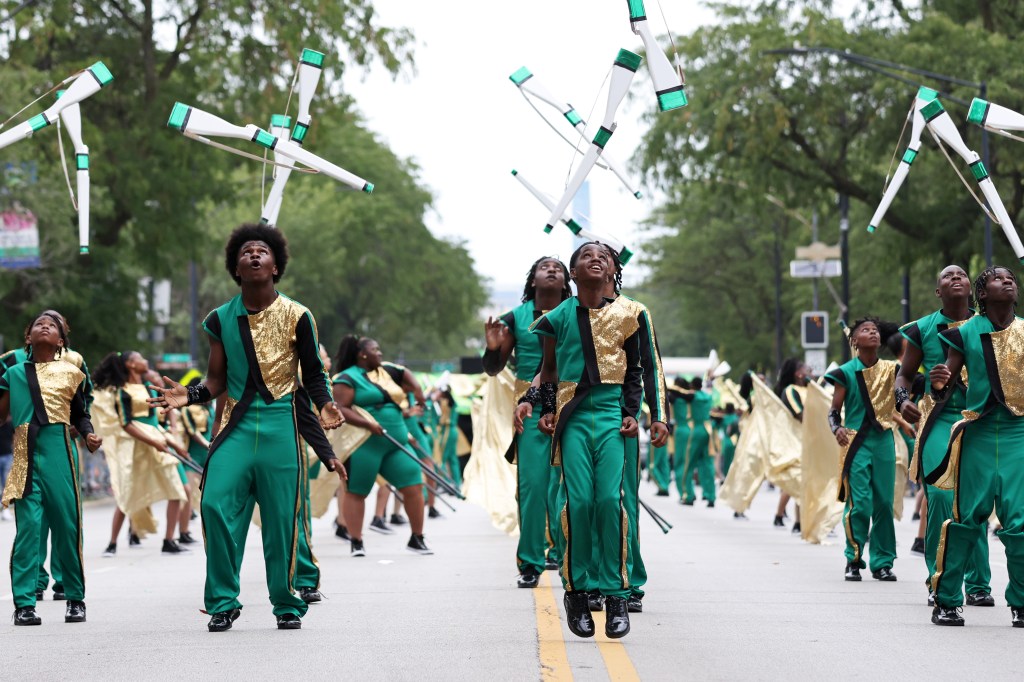Nicknamed “The Bud,” the parade has been a back-to-school celebration and showcase for Chicago’s talented young people since 1929. For four generations, the Sengstacke family has organized what it says is the largest African American parade in the United States.
Hundreds of thousands of spectators and generations of families will gather along the almost 3-mile route in Bronzeville Saturday to cheer on a variety of performers — bands, dance and drill teams, tumblers and cheerleaders — and watch honorary grand marshals and celebrities ride in style aboard floats and classic cars. And thousands of school supplies and other amenities will be handed out in Washington Park following the parade.
Can’t be there in person? Watch the parade’s live broadcast from 10 a.m.-noon on WLS-Ch. 7 and abc7chicago.com.
Where and when does the parade take place?
The parade starts at 10 a.m. at the intersection of 39th Street and South King Drive in Bronzeville and marches south to 55th Place in Washington Park.
Who is leading the parade?
Grand marshal: Jason Weaver, star of “The Chi,” “ATL” and “Drumline.” The actor and singer, who attended Illiana Christian High School in Lansing and Thornwood High School in South Holland, also portrayed Michael Jackson in the 1992 miniseries “The Jacksons: An American Dream.” And when he was 11, Weaver was the singing voice of Simba in “Lion King.”
Honorary grand marshals: Jemal King (“9 to 5 Millionaire”); Keena
Barber (WDB Marketing chief executive officer); Latisha Waters (Empiire Dance Co. chief executive officer); Hosea Sanders (WLS-Ch. 7 journalist); and Che “Rhymefest” Smith (rapper, producer, philanthropist and candidate for Chicago Public Schools
Board, 10th District).
Are there post-parade festivities?
Yes! Treats, entertainment, free hair cuts and hair braiding, school supplies, health checks for adults and children, and giveaways will be available in Washington Park following the parade until 4 p.m.
What’s the best way to get there?
Parking: Spaces are limited. Carpooling or public transportation is advised.
Chicago Transit Authority: The Green Line is your best bet; exit at the Indiana, 43rd Street, 47th Street, 51st Street or Garfield stops and walk east toward the route. If you’re taking the Red Line, exit at the 47th Street stop. Take the No. 47 bus east and get off at Prairie Avenue; the parade is two blocks east. Details about extra bus and rail service are available on the CTA website. Some bus schedules will be rerouted due to the parade.
What are the parade’s origins?
Robert Sengstacke Abbott Outside Chicago Defender Building
Robert Sengstacke Abbott / Getty Images
Newspaper founder Robert Sengstacke Abbott, at right, stands outside The Chicago Defender’s original building in Chicago, circa 1910s. Abbott championed the “Great Northern Drive” through his newspaper. (Robert Sengstacke Abbott/Getty Images)
The Chicago Defender was founded in 1905 by Robert Sengstacke Abbott.
In 1924, Abbott held a picnic for five of his publication’s newsboys.
The first parade was held Aug. 11, 1929, when Abbott wanted to thank the children who hawked his newspaper on street corners. He could think of no better way than to give them the things they loved: ice cream, hot dogs and a day outdoors.
Who is Bud Billiken?
The first appearance of Bud Billiken in the Chicago Defender
Chicago Defender Bud Billiken first appeared on the Defender Junior page in the Chicago Defender on April 2, 1921. (Chicago Defender)
In 1921, Abbott started Defender Junior, a page of his weekly paper devoted to children. It grew to include a club, drawing children across the U.S. and Africa and serving as an alternative to the Boy Scouts in response to the segregation at the time.
Bud Billiken, the page’s fictional editor/mascot described as the guardian and protector of children, was invented by Abbott and the Defender’s executive editor, Lucius Harper. Depending on which authority you ask, the two either found the word “billiken” in a dictionary or Harper had a carving of one on his desk.
Side note: Good-luck figurines called billikens were a popular culture craze in the early 1900s. Florence Pretz, a Kansas City art teacher, created the tubby little good-luck creature — a cross between a Kewpie doll and a Buddha figure — and for a while the impish-looking “god of things as they ought to be” was all the rage. The Billiken Company of Chicago manufactured dolls, banks, figurines and other souvenirs in his likeness.
Who has participated in the Bud Billiken Parade?
Many notable people have participated in the parade since its inception. Here are a few:
Politicians and civic leaders: Both Mayors Daley; the Rev. Jesse Jackson; Barack Obama, as both a U.S. senator and president; President Harry Truman; and Chicago’s first Black mayor, Harold Washington

Abel Uribe / Chicago Tribune
Singer Chaka Khan waves to fans during the Bud Billiken Parade on Aug. 9, 2014. (Abel Uribe/Chicago Tribune)
Entertainers: James Brown, Duke Ellington, Billie Holiday, Lena Horne, Chaka Khan, Spike Lee, Diana Ross and the Supremes, Oprah Winfrey and Chance the Rapper

Robert Abbott Sengstacke / Getty Images
American singer James Brown and boxing champ Muhammad Ali (then known as Cassius Clay) smile and greet paradegoers while participating in the annual Bud Billiken Parade in August 1966. (Robert Abbott Sengstacke/Getty Images)
Athletes: Muhammad Ali, Michael Jordan, Candace Parker, Joe Louis, Jesse Owens and Floyd Patterson
Sources: Chicago Defender Charities; Tribune archives and photos
Subscribe to the free Vintage Chicago Tribune newsletter, join our Chicagoland history Facebook group and follow us on Instagram for more from Chicago’s past.




















